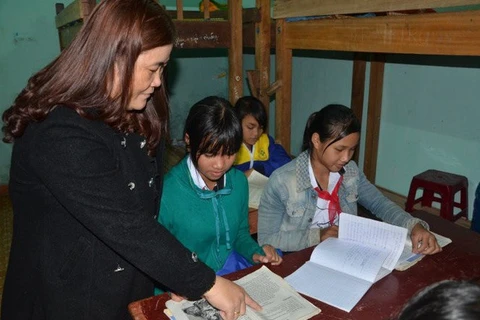Hanoi, February 19 (VNA) - There will be more than 40,260 redundant teachers when the new national curriculum for general education is implemented from 2019, according to the Ministry of Education and Training.
The largest redundancy is predicted to be at the secondary level. Secondary schools currently have nearly 311,000 teachers nationwide.
When the new educational curriculum is implemented during the period between 2020 and 2024, there will be more than 4,000 to 6,000 redundant teachers per year.
It is expected to have 21,663 redundant secondary school teachers in the school year 2023-2024.
The ministry has warned localities to review secondary school teachers and consider putting an end to new teacher recruitment.
Among 150,700 teachers currently teaching at high schools nationwide, 4,508 will be redundant in the school year 2021-2022. As many as 4,387 other teachers will be unnecessary in the school year 2022-2023. However, the high school level will need some 21 teachers in the school year 2023-2024.
There will be some 4,700 redundant teachers among the current 397,000 primary school teachers in the school year 2019-2020.
An additional 5,000 teachers at this level will be redundant in the school year 2020-2021.
However, between 2021 and 2024, primary schools will need to recruit over 5,000 more teachers.
While teacher redundancy is predicted at all levels, some subjects are predicted to still be in need of a large number of teachers.
Primary schools nationwide now need some 5,610 English teachers and 5,600 computer science teachers. To implement the new educational curriculum, some 2,000 teachers need to be recruited each year for each subject in the school years between 2021 and 2024.
Secondary schools will need to newly recruit some 2,700 teachers every year for each of two new subjects: music and art.
The new national curriculum for general education is expected to be implemented at grade one (primary school) since the school year 2019-2020, at grade six (secondary school) since the school year 2020-2021 and at grade ten (high school) since 2021-2022.
The Ministry of Education and Training has published the draft curriculum on its portal at moet.gov.vn to collect public feedback within two months. The ministry plans to officially unveil the curriculum in April this year.
Under the draft new curriculum, students are expected to have more out-of-school and creative experience, rather than only theory.
It will include compulsory practical activities for pupils to experience. Activities for primary schools will focus on developing their life skills, soft skills, relationships with friends, teachers and family.
Meanwhile, secondary education will focus on activities for social and community services and job-oriented activities.-VNA
VNA
























